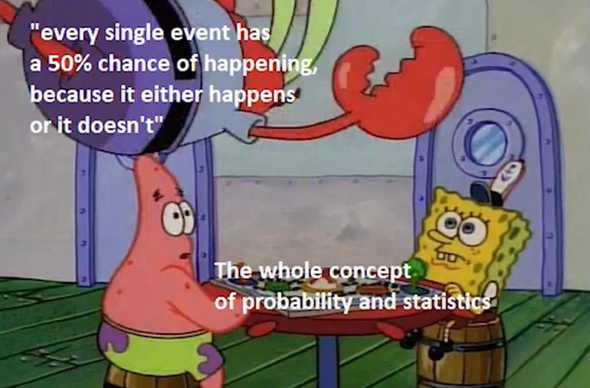7-Star Rating Scale
May 24, 2020 · 14:06 pm · Niche Idea
The human brain is not very good at conceptualizing large numbers and complicated proportions. For example, can you really imagine a chance of winning? Chances are (no pun intended) that you can’t. Most people see ” chance” and internally translate it to “close to not happening”. Likewise, we see and think “close to certain”. And when we see something like , we think “it can either happen or not”. This meme captures this idea:
A similar problem occurs with 10-Star rating scales. In too many cases are there inconsistencies in even just one reviewer; that is, among the subjects that they rate and , for example, there are some subjects that they prefer over . This makes the difference between and meaningless, and adds skepticism towards the difference between and , and and ratings.
Making the Stars Matter
Here is the elegant solution: put a tangible, human association to each ranking. We established that we are capable of clearly distinguishing tiers: nothing, everything, and about halfway. This seems to inspire a 3-Star rating system, but clearly, there isn’t enough granularity; most things would fall into the category, as is reserved for subjects without any flaws and is reserved for subjects with only flaws.
Sidenote:
I am not allowing a rating because many review systems and websites require a minimum of star. This is to ensure that a reviewer really meant to mark a subject as the lowest tier, instead of simply forgetting to star an item.
This is where a tree-like system comes in handy. At the first level, we rate a subject as either generally bad, generally good, or generally neutral. Then, we adjust the rating based on whether it is closer to the general tier below or above it. For example, I rate tangerines (as an enjoyable snack) as generally good due to its tasty nature, but since occasional seeds are unexpected and uninvited and its acidity makes it hard to eat many without getting sick, the details of a tangerine are mostly bad, resulting in a rating of .
Notice that some arrows end up on the same star. This is because generally, a subject with critical parts that are generally good and detailed parts that are mostly bad is about the same as a subject with critical parts that are neutral and detailed parts that are mostly good.
Cons
- This doesn’t solve the problem of how stars have a different meaning across different people.
- The tree-like structure may turn away some people due to its “apparent complexity”.
- is prime
Pros
- This does solve the problem of inconsistency within one reviewer. Now, a ranking by a person is necessarily better than other rankings that are lower and necessarily worse than other rankings that are higher by the same person.
- Once understood, it’s not complicated
- is not used for ranking at all, so it can be understood to have this tree-like structure.
